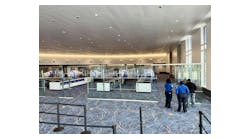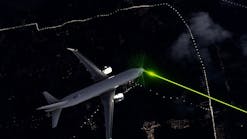In recent years, there has been a shift in the threat landscape. Attackers are zeroing in on new targets, including transportation hubs, and as a result, millions of people are vulnerable. At airports in particular, although traditional aviation threats must still be considered, the threat landscape has been expanded to non-traditional areas of the airport. Airports have reacted to this change by implementing new regulations and guidelines for employees and travelers alike.
Today, because of their complexity, airports require several security procedures and screening processes to keep both travelers and employees safe. Due to a number of high-profile events involving insider threats in recent years, both the airports and the Transportation Security Administration (TSA) have recognized the need to identify new ways to defend against this new threat. Back in 2014, in Wichita, KS, an avionics technician was arrested at the Mid-Continent Airport after he demonstrated a willingness to transport explosives to a secure part of the airport. That same year a former baggage handler smuggled guns onto passenger planes at Hartsfield-Jackson International Airport. More physical security protocols have been installed to protect the vulnerable areas of the airport however challenges do exist.
As the TSA, airport authorities, and airlines put an increased focus on identifying new employee screening processes, it’s important to understand the current procedures airports have in place today and why it’s been difficult to implement new ones. Let’s explore these two points further and also examine what airport managers should consider when reviewing potential solutions.
Looking Beyond Identification Verification to Secure Access Points
For decades, airport insiders have been given extensive access to almost all parts of the airport, with identification verification serving as the primary tool for screening airport employees. Although this process has been in place since the early 1970s, as previously mentioned, recent incidents have indicated that ID verification is not enough. In response, airports are starting to explore enhanced security procedures that will protect both the front door and the back door of the airport from physical threats.
The challenge with implementing new screening processes and procedures for airport insiders is that the solution can’t be one that slows down the pace of commerce at the airport. The level of access and freedom that employees currently have allows them to remain operational and helps to keep airports running. If a new screening process creates long lines and is time intensive, the whole operation is thrown off.
It is also important to note that TSA has been successful in implementing risk-based security and screening processes that have enhanced passenger travel. However, replicating these processes on the employee side has proved to be much more challenging. Unlike employees, travelers have limited access points and only pass through security once before boarding their plane. Employees, on the other hand, encounter dozens of access points depending on the size of the airport. The sheer number of access points makes it difficult to implement a solution that works at every point in an airport.
Leveraging Innovative Technologies to Keep Pace
With airport managers focusing their attention on combating insider threats, there is a need to start leveraging new, innovative technologies that will allow them to implement a screening process that is efficient and doesn’t slow employees down. When deciding which technologies and processes to implement, it is important to keep in mind that there is no one-size-fits-all solution. This is a complicated problem that requires a smart response. With so many products available today, let’s explore five different elements that airport managers should look for when identifying new solutions:
1. Scalable Solutions That Can Be Adapted as Conditions Change – Screening at every access point, on an ongoing basis, is an impressive commitment to security. However, studies have shown that scalable solutions can be equally as effective. This includes solutions that are designed for pop-up deployment at various locations and times with random, unpredictable screening.
When budgets are limited, there are options available that avoid implementing screening procedures that harden every door all the time. To do this successfully, airport managers should look for systems that have the flexibility to be set up and deployed for operations very quickly or installed permanently as conditions change.
2. Leveraging Smart, Automated Solutions to Focus on Priority Tasks – Today, physical employee screening processes rely heavily on two things. First, traditional “TSA style” X-rays and magnetometers. These processes are expensive and invasive for all employees. Second, random physical pat downs. This is a cheaper solution however it generates less overall penetration and is more invasive for selected employees. Regardless of which solution airport managers use, the throughput constraints, labor requirements, and impact to employees often make legacy processes difficult, if not impossible, to sustain.
As an alternative, airport managers should look for automated systems. They allow guards to focus on higher priority tasks such as quickly responding to likely threats to help screen against insider threats. In addition, these systems help to reduce the element of human error, as guards can focus on resolving specific alarms.
3. Finding Flexible Solutions That Work for Your Airport – Differentiation is an important factor that influences how widely employees will accept a new process. As noted above, there is no one-size-fits-all solution. What’s more, these approaches are cumbersome and often ineffective without additional capabilities.
Each airport needs its own flexible solution that can be adjusted based on their specific needs, budget, and risk factors. Remember, there is no perfect security solution. However, those that that strategically balance security, access, usability, and cost can ultimately provide the best long-term protection against an evolving adversary.
4. Harnessing the Power of Innovation – Today there are a variety of innovative technologies available that offer airport managers a number of benefits. For example, artificial intelligence (AI) which has the ability to analyze data quickly and identify patterns. This means guards can focus on interpreting results as opposed to watching screens.
In a screening scenario, using a system that is powered by machine learning – an advanced form of AI – means the computer can be taught to identify an object as something specific based on characteristics. This means the system can quickly determine whether an object in someone’s pocket is a cell phone. As a result, the need for full hand wanding or physical full-body pat downs is eliminated as the technology itself alerts guards if someone is carrying an item of interest and tells them where to search.
5. Considering the Pace of Commerce to Remain Operational – With new procedures looming, both employees and their employers are concerned about the negative impact new security measures will have on their jobs and their ability to perform them well. Remember, if security processes make it impossible for employees to get to work on time, airplanes won’t get off the ground on time.
To ease these concerns, and keep operations running smoothly, look to install processes that won’t create long lines and bottlenecks. For example, any solutions that require employees to empty their pockets or take off their shoes and belts are likely not the best option. As discussed previously, systems that are equipped with AI technologies are powerful enough to offer features and benefits that eliminate time-consuming processes.
When it comes to employee screening, airports are already showing a tremendous ability to stay ahead of the curve. Airports that are using technology that is aligned with their limited resources to incorporate additional layers of security have successfully been able to improve their employee screening process in a way that doesn’t harden their facility completely. While the use of identity verification continues to be vitally important, it is the combination of identity and physical security that will enable airports to successfully protect against insider threats.
Chris McLaughlin, Vice President Global Solutions at Evolv Technology
Chris McLaughlin joined Evolv Technology in the fall 2016 to lead work in the transportation sector. In this role, he leads engagement with airports, airlines, and rail organizations and assists in other sectors to develop concepts of operation and configurations that integrate into existing and emerging landscapes.
Prior to joining Evolv, Chris worked for the Transportation Security Administration first as a Federal Security Director in Colorado and then as the Assistant Administrator for Security Operations where he led a team of 56,000 employees across more than 450 airports nationwide and managed a budget of $4 billion. As a national policy maker, he worked closely with national industry associations, other federal agencies, and Congress, and was instrumental in shaping and advancing TSA’s current philosophy of risked based security. Chris also led field operations and security for the biometric security provider, CLEAR, as well running ground operations at major hubs and line stations for United Express and Frontier Airlines. Following in his father’s footsteps, he started his career as a self-employed blacksmith, providing top end farrier services in the mountains of Colorado.






